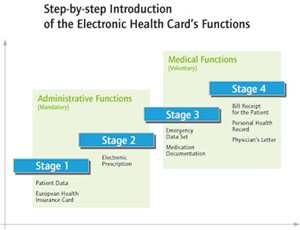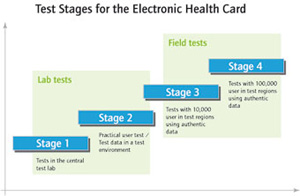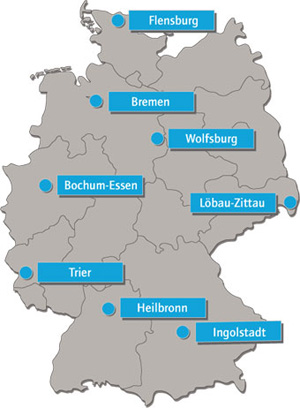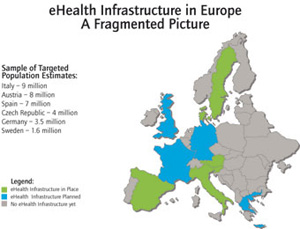Even the biggest critics therefore do not doubt the aims of the health card. And the project's technical feasibility â after all, one of the largest IT projects worldwide â is undisputed. The technologies used for this purpose are already successfully applied in other areas. At the center of criticism was rather the stubborn political dispute about the responsibilities and the overall conditions for the card and the required health care IT infrastructure, which is supposed to network around 300 health insurance companies, 2,200 hospitals, 21,000 pharmacies, 188,000 physicians and dentists as well as 80 million patients. Back in 1999, the founding of the "Action Forum for Telematics in the Health System (ATG)" was an initial step towards a uniform IT infrastructure in the German health care system. Four years later, the German Statutory health Insurance Modernization Act (GMG) was passed, which defines the precise requirements made on the card and its infrastructure.
Step-by-Step Introduction
Since then, heavy political disputes delayed the project several times, but one thing is a fact meanwhile: the card and its infrastructure will be introduced in several steps starting in 2007. At the beginning of the introduction phase, the old insurance card will be valid parallel to the new electronic health card for a certain period.

Source: Gematik
The individual functions of the card will also be introduced in several steps:
The administrative functions will be implemented first. In an initial step, the patient data saved on the card will be activated and can then also be updated at any time when the patients use the card at their physician's office or in a pharmacy. A reduction of the abuse potential is expected because the card features a photo of the patient and can be blocked online in case it is lost or stolen. According to experts, the abuse potential is estimated to be between one or two million Euros annually. In addition, the card will feature the European Health Insurance Card (EHC) on the back upon its introduction, which replaces the health insurance document for abroad.
The electronic prescription application will be introduced in the second stage. This will make it possible to transmit and settle the around 700 million prescriptions each year fully electronically, which prevents expensive information media switches and creates the basis for further drug safety improvements in step three.
While only applications that are mandatory for all citizens will have been introduced until then, step three sees the introduction of the first voluntary medical applications. These include the emergency data set and medication documentation based on e-prescriptions. They are the basis for improving emergency treatment and increasing drug safety.
Further voluntary applications will then be introduced in the fourth step: the bill receipt for patients gives them an overview of the prices of services rendered by their physicians, and the electronic physician's letter speeds up the treatment of intersectoral or interdisciplinary cases. And finally, the improvement of the medical care quality, which is the aim of the health card project, will become reality with the introduction of the personal health record. The record contains all relevant medical data in a clearly structured form. With the patient's consent, physicians can access this information, edit it and add new data. This expanded information basis enables better treatment decisions, which also consider diagnoses, therapies and the results obtained by other physicians.
The demands of the GMG on the card and its infrastructure will be fulfilled with the introduction of the fourth stage. However, the health card has an open infrastructure so that new added-value applications can be integrated at any time later on to contribute to a more efficient health care system.
Test Phase Started
Meanwhile, many basic decisions were made after long discussions and the health card project is becoming more dynamic. The specifications for the first elements of the health care IT infrastructure, e.g. for the electronic health card and the required card readers, are now available. First invitations to tender for the required components were issued and additional specifications and invitations to tender will soon follow. The long-awaited test phase started at the end of 2005 with the commissioning of a test lab at Gematik gGmbH, which is in charge of the introduction, maintenance and advance development of the electronic health card and its infrastructure. It was decided to perform the tests in four subsequent stages.

Source: Gematik
In the first test stage, the individual components of the new health care IT infrastructure are tested in the central test lab and released for application in the field tests. For this purpose, the individual components â e.g. the electronic health card or card readers â are tested under lab conditions with test data. The components are checked for their function and their technical attributes, among other things. So-called integration tests are performed besides these component tests and serve to examine the technical compatibility and interaction of the different components in the overall system. A material test is also performed to check the electrical, physical and mechanical properties and ensure user security. In addition, the German Federal Office for Information Security (BSI) performs an IT safety certification and confirms the compliance with the regulations of the German Signature Act (SigG).
The lab phase is a continuous process, which serves to test the additional applications like patient data and e-prescription besides the basic functions of the electronic health card. Among these are the emergency data set, the medication documentation, the bill receipt for patients, personal health records and the electronic physician's letter.
Initial practice tests in test offices, pharmacies and hospitals follow in the second test stage, in which the released devices are tested in a test environment. For security reasons, these tests are only performed with test data.
Field Tests in Eight Regions
After the successful conclusion of the practice tests, the components are applied in field tests, which will take place in eight test regions in various German federal states. In the selected test regions, the involved health insurance companies, medical service providers and further partners can look back on long-standing experience in the establishment of IT infrastructures. Up to 10,000 citizens, 15 to 25 physicians, three to five pharmacists and one to two hospitals are registered for practical testing per test region. The payers in charge (health insurance companies) are also integrated in the tests.

Source: Gematik
All regions test the mandatory applications of the electronic health card. Besides the mandatory applications e-prescription and patient master data, they each have different test focuses: Wolfsburg will concentrate on the emergency data set, Trier on the electronic health professional card (HPC) and Bremen focuses on medication documentation.
Financing Secured
The service providers participating in the test receive a flat fee from Gematik for equipment costs for the initial purchase of components like card terminals or connectors to the health care IT infrastructure. Another budget is available for covering extra personnel and operational expenditures resulting from the test. This amount is supposed to finance the additional consultancy services for patients as well as personnel training.
The following fees were agreed:
- Physicians: 3,000 Euros flat fee / 3,200 Euros for additional expenses
- Pharmacies: 3,000 Euros flat fee / 2,750 Euros for additional expenses
- Hospitals: 28,000 Euros flat fee / 28,000 Euros for additional expenses
After completion of the tests with 10,000 patients, two test regions will be expanded to up to 100,000 citizens and the payers and service providers in charge of them. At the same time, the remaining regions will continue their tests until the general introduction of the electronic health card, which is supposed to take place after the completion of the tests with 100,000 patients.
Additional field tests are performed for the electronic health card parallel to the official test regions, sponsored by companies or public-private partnerships. In these regions, the focus is above all on innovative added-value applications for the card. In addition, the card's technology and its infrastructure are to be developed further to such an extent that it can be optimally integrated into the workflows of the service providers. Besides this, these field tests are to contribute to the card's acceptance among the population.
The European View
Other European states are also working on the introduction of health care IT infrastructures or electronic health cards. The European Union is therefore striving for standardization to ensure the transnational interoperability of the solutions.

Source: Directorate-General for Employment, Social Affairs and Equal Opportunities of the European Commission
The European Health Insurance Card (EHIC) was introduced as a first step towards achieving this aim, and is already available in many countries these days as an additional card to the health insurance ID. It replaces the health insurance document for abroad so far required in case of illness or accidents and enables unbureaucratic medical treatment in Europe. Right from the start, the EHIC will be featured on the back of the German electronic health card.
Based on this, health data sets like emergency data or medication documentation will also be made available Europe-wide as voluntary health card applications. This way, patients who agree to have their medical data saved in a personal health record via the health card can also receive better treatment abroad in Europe, because physicians can quickly access emergency data or other important information like drug documentation.
In the "Action Plan for a European e-Health Area", the European Commission postulated the aim to make electronic health care services a matter of everyday life for medical personnel as well as for patients and citizens in Europe until the year 2010 â an aim that is ambitious but achievable. This is what the successful rollout of the eCard in Austria as well as the meanwhile rapidly advancing German health card project have shown so far.
Author:
InterComponentWare AG
Dirk Schuhmann
Otto-Hahn-StraÃe 3
69190 Walldorf
Tel: ++49(0)6227-385-133
Fax: ++49(0)6227-385-199
E-mail: This email address is being protected from spambots. You need JavaScript enabled to view it.
www.icw-global.com
www.LifeSensor.com